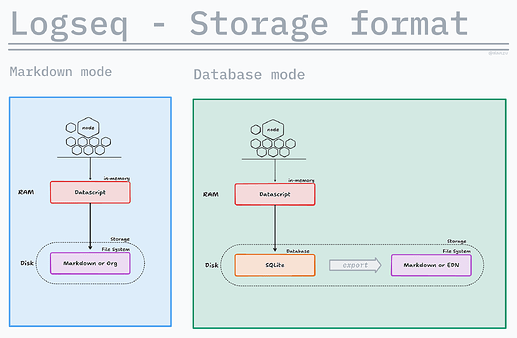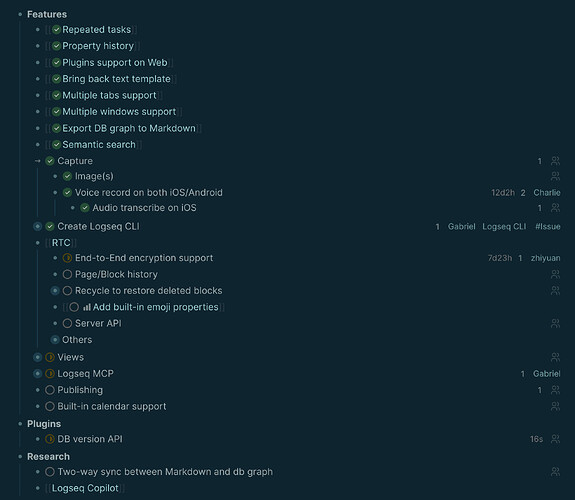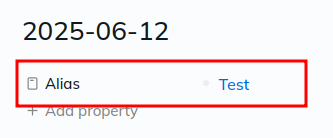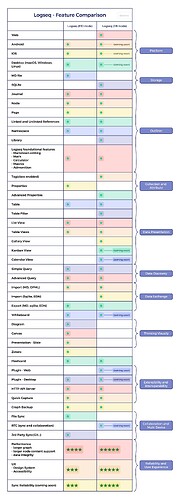WARNING: Logseq DB is still in beta. Use only at own risk of losing data.
This post is for people who have questions about the new database (DB) version of Logseq. For the official announcement about the database version, see this post from April 2024.
In writing this FAQ I don’t claim to speak for the team. Also, I am not a programmer and might make some mistakes. I’m just doing the best I can based on information I’ve seen posted on Discord and the Forums.
You can link directly to the FAQ with this short URL: https://bit.ly/logseqfaq
Table of Contents
- What happened to markdown files?
- Can I continue using the MD version of Logseq?
- What are NewTags?
- How (and why) to extend tags?
- Can we import our MD graph?
- What happened to whiteboards?
- What happened to Zotero?
- Is there a desktop app for Logseq DB?
- What happened to sync?
- What is Logseq Pro?
- Will we be able to self-host Logseq DB?
- When will it be released?
- Will there be a calendar view?
- Will the mobile app support plugins?
- What is the Library?
- How can I help test the mobile apps and RTC?
- What is the MCP and how to use it?
What happened to markdown files?
Both the original Markdown (MD) based version of Logseq and the DB version use an internal database when you are using the app. The difference is that, in the MD version, the files are always canonical. In the DB version, while you will be able to export to markdown files, the database version is always canonical.
This chart from @danzu shows how it works. When you are using either version of Logseq, it reads from in-memory database running on “Datascript.” The MD version stores the disk version in MD files, while the DB version stores the disk version in SQLite (an embedded database).
What does this mean? In the MD version, you can modify your graph by editing the MD files directly. In the DB version you cannot do this. Some flexibility is lost as a result, but in exchange we will get better sync, real time collaboration (RTC), and less data loss.
Note, however, that sync and RTC will be part of “Logseq Pro” and require a subscription. See more on sync below.
The team is looking into the possibility of having continuous real-time export of your database into markdown files, but haven’t committed to doing so. As I understand it, this would be one-way sync, and would not read changes in the markdown files back to the database.
Can I continue using the MD version of Logseq?
Yes, the new desktop app supports both MD and DB graphs, and will continue to be supported. However, the new web-based version of the app will only support DB graphs. On mobile there will be separate apps for MD and DB graphs. Also, MD and DB graphs will sync in different ways, with MD graphs using the existing sync solution, while the new DB graphs will require RTC sync, which will be part of “Logseq Pro.” (More on sync below.)
What are NewTags?
Actually, they are just called “tags” but I call them “NewTags” here to make it clear that things have radically changed from the current MD app. This is one of the most exciting features of the DB version and will radically change how you use the app. The short version is that properties are now associated with NewTags, and assigning a NewTag to an item will automatically populate that item with those property fields.
So, for instance, you could associate “Telephone Number” and “E-mail Address” with #Contact .
See my post on how tags work in Logseq DB for more information.
How (and why) to extend tags?
Even better, you can build on existing NewTags by creating tags that inherit the properties of their parent tags. This is called “extending tags.” How this works is explained in this post by @brerlapn.
Can we import our MD graph?
Yes, you can. Right now it is recommended to use the “File to DB Graph” option, and not the “EDN to DB Graph” option.
Note that #tags and [[page references]] are handled the same in the MD version but are different in the DB version. (See about NewTags above.) This will affect how your graph gets imported, depending on which options you choose during the import process. You should experiment with different options to see how you want to handle it. Importing will not affect the original MD files.
Personally, I recommend playing with the new DB graph on its own for a while first, so you understand how it is different before importing your old data.
What happened to whiteboards?
Whiteboards have been removed from the DB version of the app, temporarily, but will still work in the MD version of the combined desktop app.
They will come back after the team decides how best to handle them.
What happened to Zotero?
Zotero will no longer be supported as part of the core app. One will have to rely on plugins, like Zotero-local. The developer of Zotero-local has promised to update the app after the desktop app is released.
Is there a desktop app for Logseq DB?
A new combined desktop app is due to be released shortly. You can already try a pre-release build from this page. (You have to be logged in to GitHub in order to see the download links.)
This app allows you to open either MD or DB graphs. The DB version is still in beta though, and they strongly recommend against using it for important work. Also, back up your MD graph before trying it as well, and note that some changes may affect how your MD graph behaves, especially if you depend on plugins. (Not all plugins will work with this new version of the app.)
The new combined (MD and DB) desktop app fixes hundreds of bugs for MD users, but also breaks some workflows, especially those related to plugins, or some features which have been removed to become plugins, like Zotero integration. (See below for more on this.)
The DB version also exists now as a web app, which still stores data locally (not in the cloud). Everyone is free to try it at https://test.logseq.com/ (It is recommended that you only use it with Google Chrome, and turn on the backup feature under the “export” menu on the top-right.)
The old, MD-only, app still exists and gets occasional updates. It can be downloaded from the Logseq homepage. That is the 0.10.x version. The new, combined app is the 0.11.x version.
What happened to sync?
There will be two sync solutions going forward. MD sync will continue to work as it does now, while the DB version will be part of “Logseq Pro” which will include real time collaboration (RTC) and publishing as well. It should be much faster and more reliable than the MD sync.
Logseq Pro will hopefully make Logseq profitable and allow for the company to be sustainable over the long term, so the team is putting a lot of work into making sure that these features work flawlessly.
Note that there will be two different mobile apps going forward. The old ones will continue to be updated and will support MD graphs, and the new ones will be for DB graphs. Each will sync in a different way.
MD graphs in desktop app ↔️ current sync solution ↔️ old mobile app
DB in desktop or on web ↔️ RTC ↔️ new mobile apps
What is Logseq Pro?
See the official FAQ.
Will we be able to self-host Logseq DB?
See this discussion
When will it be released?
Tienson shared this internal roadmap on September 25th. Since they have made some notable improvements to data integrity and the plugin API. A full changelog can be found here, and a short summary of what they have done over the past year can be found here.
The final, “Research,” section will probably not be part of the initial release, but almost all the other features (except for publishing and the planned calendar feature) are already there, though some still need work. Since this chart was first shared, they have already released versions of the Server API, the MCP, and the plugin API.
There is no official timeline, but the new desktop app, iOS mobile app, and RTC sync are already being used regularly by some testers. The Android app should be released soon, as well as an update to RTC that will support end-to-end encryption. Once these are deemed reliable enough, the testing pool will be expanded, and eventually opened up to anyone who wants to try.
Right now, the new web app, and the new desktop app (see above) are already available for testing by anyone who wants to try them.
Will there be a calendar view?
Yes, supposedly a calendar view is planned. There are no details on it yet.
Will the mobile app support plugins?
It seems that there are plans to do this eventually, but right now the priority is to release the app and sync, so work on this will not happen for some time.
What is the “Library”?
One feature that has gotten very little attention from Logseq over the years is the “namespace” feature, which gives users the ability to have some additional hierarchy. In the MD version this feature was never even properly documented.
It seems that, in the MD version, the primary use intended for the feature was to avoid conflict between two identically spelled words that have different meanings. For instance, you might want to differentiate a page for “apple” when applied to Apple Computers, and for Apple Pie. You could do this by putting them in separate namespaces: [[computer/apple]] and [[pie/apple]].
Now, however, the team has added a new “Library” feature to the DB app, which should make this easier, and make namespaces more useful.
What is Library? According to the PR for this feature , it is a “page to automatically collect namespace pages.” You can watch the demonstration video on that page, but the idea is simple. If you write [[computer/apple]] it will actually make it [[library/computer/apple]] and on the page [[library]] you will see an outline of all the page names that have hierarchy. You can edit them by simply dragging and dropping those pages in the outline, and you can add additional namespaces as well.
This should make editing hierarchy much easier, and allow people to give their Logseq notes more structure if they need to.
Note: this feature is still in development.
How Can I Help Test the Mobile Apps and RTC?
Here is the form to request to be included in the pool of testers for the new iOS and Android apps:
And here is the form to request to be included in the RTC (Real Time Collaboration) test pool, necessary to sync mobile apps with the desktop:
What is the MCP and how to use it?
According to Wikipedia, “a Model Context Protocol (MCP) is an open standard, open-source framework introduced by Anthropic in November 2024 to standardize the way artificial intelligence (AI) systems like large language models (LLMs) integrate and share data with external tools, systems, and data sources.” Even though it was introduced by Anthropic (the makers of Claude AI), it is now widely supported.
The Logseq MCP can interface with online LLMs like Claude or OpenAI, or offline ones, like Gemma, to let you directly interact with your graph. Like the API, this requires using the desktop app, not the web app (see above).
Documentation is still rough, but instructions for setting up the new Logseq MCP can be found here.



